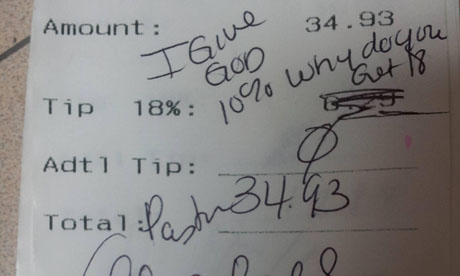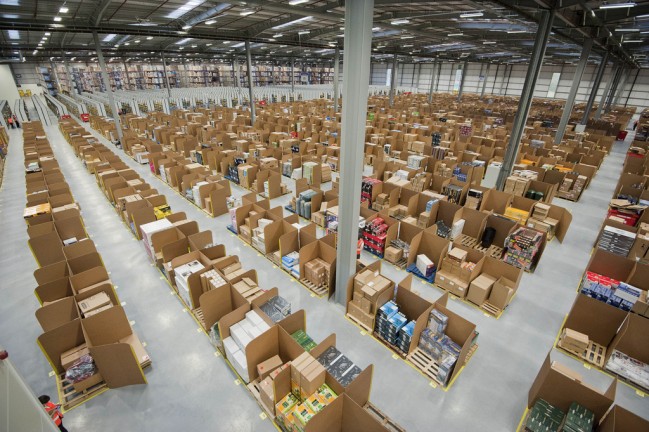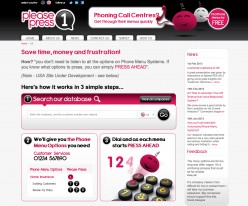 Contrary to popular opinion espoused by retail management, service companies and business “gurus”, the customer is not always right. In fact, the customer is sometimes arrogant, ignorant and wrong.
Contrary to popular opinion espoused by retail management, service companies and business “gurus”, the customer is not always right. In fact, the customer is sometimes arrogant, ignorant and wrong.
From the Guardian:
I was a waitress at Applebee’s restaurant in Saint Louis. I was fired Wednesday for posting a picture on Reddit.com of a note a customer left on a bill. I posted it on the web as a light-hearted joke.
This didn’t even happen at my table. The note was left for another server, who allowed me to take a picture of it at the end of the night.
Someone had scribbled on the receipt, “I give God 10%. Why do you get 18?”
I assumed the customer’s signature was illegible, but I quickly started receiving messages containing Facebook profile links and websites, asking me to confirm the identity of the customer. I refused to confirm any of them, and all were incorrect.
I worked with the Reddit moderators to remove any personal information. I wanted to protect the identity of both my fellow server and the customer. I had no intention of starting a witch-hunt or hurting anyone.
Now I’ve been fired.
The person who wrote the note came across an article about it, called the Applebee’s location, and demanded everyone be fired — me, the server who allowed me to take the picture, the manager on duty at the time, the manager not on duty at the time, everyone. It seems I was fired not because Applebee’s was represented poorly, not because I did anything illegal or against company policy, but because I embarrassed this person.
In light of the situation, I would like to make a statement on behalf of wait staff everywhere: We make $3.50 an hour. Most of my paychecks are less than pocket change because I have to pay taxes on the tips I make.
After sharing my tips with hosts, bussers, and bartenders, I make less than $9 an hour on average, before taxes. I am expected to skip bathroom breaks if we are busy. I go hungry all day if I have several busy tables to work. I am expected to work until 1:30am and then come in again at 10:30am to open the restaurant.
I have worked 12-hour double shifts without a chance to even sit down. I am expected to portray a canned personality that has been found to be least offensive to the greatest amount of people. And I am expected to do all of this, every day, and receive change, or even nothing, in return. After all that, I can be fired for “embarrassing” someone, who directly insults his or her server on religious grounds.
In this economy, $3.50 an hour doesn’t cut it. I can’t pay half my bills. Like many, I would love to see a reasonable, non-tip-dependent wage system for service workers like they have in other countries. But the system being flawed is not an excuse for not paying for services rendered.
I need tips to pay my bills. All waiters do. We spend an hour or more of our time befriending you, making you laugh, getting to know you, and making your dining experience the best it can be. We work hard. We care. We deserve to be paid for that.
I am trying to stand up for all of us who work for just a few dollars an hour at places like Applebee’s. Whether a chain steakhouse or a black-tie establishment, tipping is not optional. It is how we get paid.
I posted a picture to make people laugh, but now I want to make a serious point: Things like this happen to servers all the time. People seem to think that the easiest way to save money on a night out is to skip the tip.
I can’t understand why I was fired over this. I was well liked and respected at Applebee’s. My sales were high, my managers had no problems with me, and I was even hoping to move up to management soon. When I posted this, I didn’t represent Applebee’s in a bad light. In fact, I didn’t represent them at all.
I did my best to protect the identity of all parties involved. I didn’t break any specific guidelines in the company handbook – I checked. But because this person got embarrassed that their selfishness was made public, Applebee’s has made it clear that they would rather lose a dedicated employee than an angry customer. That’s a policy I can’t understand.
I am equally baffled about how a religious tithe is in any way related to paying for services at a restaurant. I can understand why someone could be upset with an automatic gratuity. However, it’s a plainly stated Applebee’s policy that a tip is added automatically for parties over eight like the one this customer was part of. I cannot control that kind of tip; it’s done by the computer that the orders are put into. I’ve been stiffed on tips before, but this is the first time I’ve seen the “Big Man” used as reasoning.
Obviously the person who wrote this note wanted it seen by someone. It’s strange that now that the audience is wider than just the server, the person is ashamed.
I have no agenda here. I seek no revenge against the note writer. I have no interest in exposing their identity, and, at this point, I’m not even sure I want my job back. I was just trying to make a joke, but I came home unemployed.
I’ve been waiting tables to save up some money so I could finally go to college, so I could get an education that would qualify me for a job that doesn’t force me to sell my personality for pocket change.
While this story has garnered immense media attention, my story is not uncommon. Bad tips and harsh notes are all part of the job. People get fired to keep customers happy every day.
As this story has gotten popular, I’ve received inquiries as to where people can send money to support me. As a broke kid trying to get into college, it’s certainly appealing, but I’d really rather you make a difference to your next server. I’d rather you keep that money and that generosity for the next time you eat out.
Read the entire article here.
Image: Customer receipt courtesy of the Guardian.


 Good customer service once meant that a store or service employee would know you by name. This person would know your previous purchasing habits and your preferences; this person would know the names of your kids and your dog. Great customer service once meant that an employee could use this knowledge to anticipate your needs or personalize a specific deal. Well, this type of service still exists — in some places — but many businesses have outsourced it to offshore call center personnel or to machines, or both. Service may seem personal, but it’s not — service is customized to suit your profile, but it’s not personal in the same sense that once held true.
Good customer service once meant that a store or service employee would know you by name. This person would know your previous purchasing habits and your preferences; this person would know the names of your kids and your dog. Great customer service once meant that an employee could use this knowledge to anticipate your needs or personalize a specific deal. Well, this type of service still exists — in some places — but many businesses have outsourced it to offshore call center personnel or to machines, or both. Service may seem personal, but it’s not — service is customized to suit your profile, but it’s not personal in the same sense that once held true.